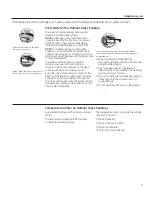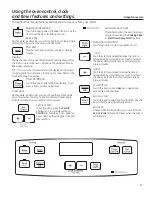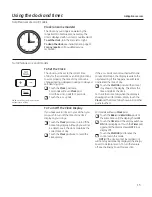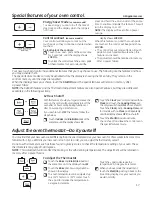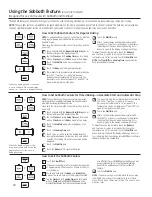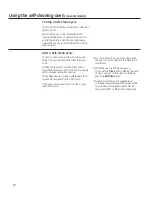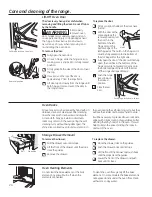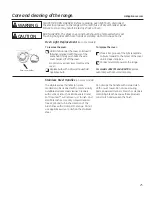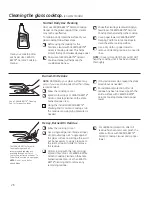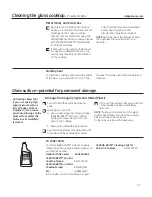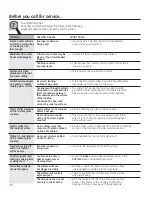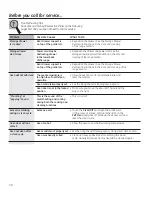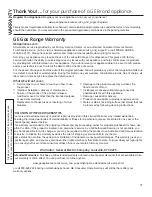
Radiant glass models:
Coil cooktop models:
Oven Vent on Radiant Glass or Coil Cooktops
On glass cooktop models, the oven vent is
located behind the right-rear surface unit.
On coil cooktop models, the oven is vented
through an opening under one of the rear
surface units.
This area could become hot during oven use.
It is normal for steam to come out of the vent,
and moisture may collect underneath it when
the oven is in use.
The vent is important for proper air circulation.
Never block this vent.
Care and cleaning of the range.
GEAppliances.com
Porcelain Oven Interior
(on standard-clean models)
With proper care, the porcelain enamel finish on
WKHLQVLGHRIWKHRYHQ³WRSERWWRPVLGHVEDFN
DQGLQVLGHRIWKHGRRU³ZLOOVWD\QHZORRNLQJIRU
years.
Let the oven cool before cleaning. We recommend
that you wear rubber gloves when cleaning the
oven.
Soap and water will normally do the job. Heavy
spattering or spillovers may require cleaning with
a mild abrasive cleaner. Soap-filled scouring pads
may also be used.
Do not allow food spills with a high sugar or acid
content (such as tomatoes, sauerkraut, fruit juices
or pie filling) to remain on the surface. They may
cause a dull spot even after cleaning.
Household ammonia may make the cleaning job
easier. Place 1/2 cup in a shallow glass or pottery
container in a cold oven overnight. The ammonia
fumes will help loosen the burned-on grease and
food.
If necessary, you may use an oven cleaner. Follow
the package directions.
Do not spray oven cleaner on the electrical
controls and switches because it could cause
a short circuit and result in sparking or fire.
Do not allow a film from the cleaner to build up
RQWKHWHPSHUDWXUHVHQVRU³LWFRXOGFDXVHWKH
oven to heat improperly. (The sensor is located
at the top of the oven.) Carefully wipe the sensor
clean after each oven cleaning, being careful
not to move the sensor as a change in its
position could affect how the oven bakes.
Do not spray any oven cleaner on the oven
door, handles or any exterior surface of the
oven, cabinets or painted surfaces. The cleaner
can damage these surfaces.
23
The gasket is designed with a gap
at the bottom to allow for proper air
circulation.
'RQRWUXERUFOHDQWKHGRRUJDVNHW³LW
has an extremely low resistance to
abrasion.
If you notice the gasket becoming
worn, frayed or damaged in any way
or if it has become displaced on the
door, you should have it replaced.
To clean the inside of the door:
On self-clean models:
Because the area inside the gasket is
cleaned during the self-clean cycle, you do
not need to clean this by hand.
The area outside the gasket and the door
liner can be cleaned with a soap-filled
or plastic scouring pad, hot water and
detergent. Rinse well with a vinegar and
water solution.
On standard-clean models:
Soap and water will normally work. Heavy
spattering or spillovers may require cleaning
with a mild abrasive cleaner. Soap-filled
scouring pads may also be used.
See also
Porcelain Oven Interior
section.
To clean the outside of the door:
Use soap and water to thoroughly clean the
top, sides and front of the oven door. Rinse
well. You may also use a glass cleaner to
clean the glass on the outside of the door.
Do not let water drip into the vent openings.
If any stain on the door vent trim is
persistent, use a soft abrasive cleaner and a
sponge-scrubber for best results.
Spillage of marinades, fruit juices, tomato
sauces and basting materials containing
acids may cause discoloration and should be
wiped up immediately. When surface is cool,
clean and rinse.
Do not use oven cleaners, cleaning powders
or harsh abrasives on the outside of the
door.
Cleaning the Oven Door
Summary of Contents for JBS10 series
Page 33: ...Notes GEAppliances com 33 ...
Page 34: ...34 Notes ...

